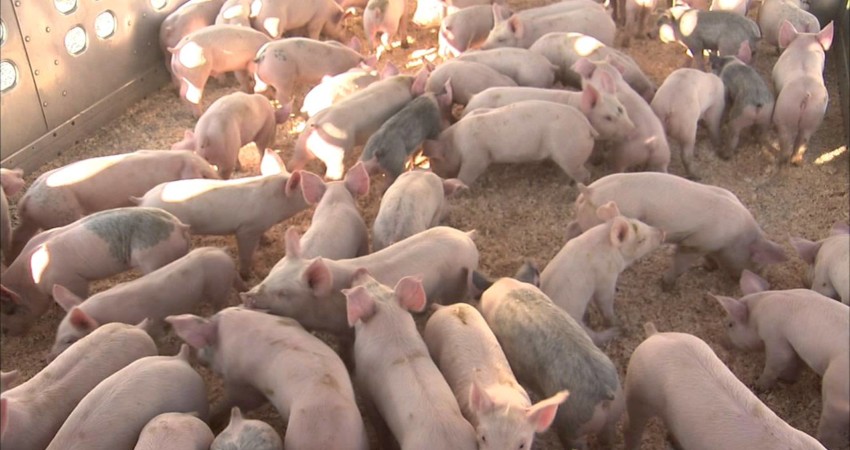

Feeds take up to 80 per cent of pig production costs. Farmers can make their own feeds and sell surplus feed to other farmers. What they need is to know the rations of mixing the different ingredients. Pig rearing is once again becoming popular due to increased pork consumption in most of Uganda’s urban areas. More farmers are venturing into the business to diversify their farming activities and take advantage of the good prices offered by processing companies However, feeding of pigs is a major challenge for most of the pig farmers. Pig feeds are expensive, taking up to 80 per cent of a farmer’s production costs.
Pig feed should be of high quality to ensure the pigs grow to the desired weight for the market. Due to the huge demand for information on pig feeding, farmers need information on pig feeding and more feed formulations that can help them cut the cost of pig production:
Piglets
Young pigs do not take much in terms of solid feed because they get all their nutritional needs from their mothers’ milk. To ensure piglets get enough milk from suckling during the early stages of growth, farmers should give the sows adequate and balanced feed to ensure they produce adequate milk for the piglets. At three weeks after farrowing (birth), the farmer should castrate all male piglets and start to train them to eat solid feeds. Suckling piglets should also have their sharp teeth clipped, three days after farrowing to prevent them causing injury to their mother during suckling.
Assuming a farmer has 10 piglets to feed, they can isolate a creep area (housing for young ones) where their mother cannot reach and put in 50g of feed per piglet per day. Observe the feeding daily; if you see the feed reducing, add another 50g for each into their feeding trough to make it 1kg.
At 5 weeks (35 to 42 days) add another 50g per piglet to make it 150g. The piglets should always have access to their mother in case they want to suckle. They should also have access to clean water at all times. Weaners At 6 weeks, each piglet should be getting 200g of feed per week. If they finish the feed, keep on adding an extra 50g per piglet daily.
During the feeding process, the farmer should weigh the pigs weekly (a healthy pig at this stage should add at least 900g per day). If there is an increase in weight at this rate, it means that the pigs are growing well. Weaners should be given dry feed at all times to prevent scouring or diarrhoea. Give adequate clean water at all times.
Porkers
At 14 weeks, the pigs will require additional feed; the farmer can give 1.4kg of extra feed per pig per day. In addition, the farmer should continue giving the 50g of feed as they were doing before. Divide the pig feed into three equal portions: A wet ration in the morning at 7 am (feed mixed with water), a dry feed at noon (feed with no water) and a final wet feed (feed mixed with water) at 4 pm. A well-fed porker pig should add an extra 300g of weight per day (weigh them regularly and record their weight to monitor their growth).
Baconers
At 22 weeks, the pigs (now called baconers) require a higher feed ration as they are about to attain the market liveweight of between 80-90kg. At this stage the farmer should give them 2.5 – 2.75kg of feed per pig per day. From 23 weeks, the feed should be increased to 3kg (1kg of wet feed in the morning, 1kg of dry feed at noon and 1kg of wet feed at 4pm). If well managed at this stage pigs can attain up to 100kg in 5 months.
At this stage the farmers can now do selection of the pigs to determine those that can go to the abbattoir for slaughter, young female pigs (gilts) can be served and sold to interested farmers while others can be retained for breeding as sows. The boars (male pigs) can also be sold or retained for breeding purposes (be careful to ensure the pig does not serve its daughters or related pigs to avoid inbreeding). A well-managed baconer should add an extra 900g to 1000g (1 kg) per day.
Sows
Sows need special attention in feeding. A sow’s yield can be as high as 16-17 litres of milk per day. To produce this amount of milk, a sow has to be well fed, both for body maintenance and milk production. A sow with piglets that are suckling requires 6 kilogrammes of feed every day or an amount of feed that is equal to 25 % of her body weight. The feeding should be divided into 3 rations (2kg of wet feed in the morning, 2kg of dry feed at noon and 2kg of wet feed at 4pm). Like other pigs, sows should be given adequate and clean water at all times.
Gilts
A female pig that is not yet served (gilts) should be given at least 3kg of feed per day. The farmer can supplement this with any other available feed in addition to this ration to keep them in good shape in terms of health and reproduction.
Boars
Male pigs (boars) should not be given a lot of feed. If given more feed, they tend to put more weight and this compromises their fertility. A boar should be given 3 to 4 kg of feed per day. Some farmers give less or even starve them in order to reduce fattening. Give them clean water at all times.
 Contact Jaguza Support
Contact Jaguza Support